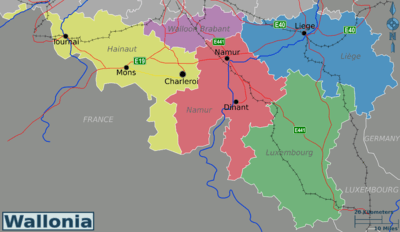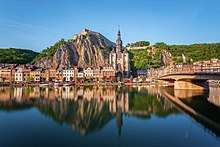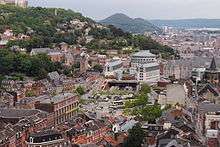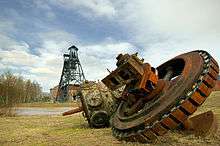Wallonia
Wallonia is the French-speaking southern part of Belgium. Bordered by Flanders in the North and France in the South-West, its Eastern border is shared by Luxembourg and Germany. While it is Brussels and Flemish cities like Antwerp, Ghent and Bruges, as well as the Flemish seaside, that see most of the tourist traffic in Belgium, Wallonia is no less interesting.
More hilly than the country's North, it has beautiful landscapes, and its cities have a lot of preserved history predating the industrial age. A characteristic shared by the entirety of Belgium are short distances and efficient public transportation, coupled with being very close to major international hubs. That said, in relation to some popular regions of Europe, Wallonia as a whole is a bit off the beaten track and the tourist infrastructure is not always as good as it could be. Furthermore, the region is proudly francophone to the point of some of its people not inclined to master other languages, so at least rudimentary knowledge of French can make all the difference.
Provinces

| Hainaut Erstwhile centre of heavy industry and mining now suffering from their decline, but nonetheless full of surprising discoveries to be made. |
| Liège Centered around Wallonia's largest city, it is the last region to feature functioning heavy industry - along with green rolling hills over the river Meuse. This is also where you will meet native speakers of German, Belgium's third official language. |
| Luxembourg In contrast to the industrialized and urbanized neighbours to the North, this sparsely inhabited region is mostly covered with lush forests and the Ardennes mountains. It shares its name and history with the Grand Duchy of Luxembourg. |
| Namur Upstream the Meuse, with a mountainous landscape, Wallonia's namesake capital and the picturesque city of Dinant |
| Walloon Brabant The Wallon counterpart to Flemish Brabant, both surrounding the country's capital Brussels |

Cities

- 🌍 Namur - the capital of the Walloon Region
- 🌍 Arlon - a wealth of Roman archeological sites - and the source of Kinder Surprise chocolate eggs
- 🌍 Bastogne - a major World War II remembrance site
- 🌍 Charleroi - the birthplace of the Belgian comic book culture, formerly centre for Wallonian coal mining, now the site of one of Europe's most popular low-fare airports
- 🌍 Dinant - a beautiful town stretching along the Meuse against a steep rock
- 🌍 Liège - Wallonia's largest city with wide boulevards, rolling hills and a bewildering architectural mix
- 🌍 Mons - where the centuries-old, UNESCO-listed Ducasse festivities take place on the impressive Grand Place
- 🌍 Spa - the original "spa", famed for healing cold springs since the 14th century
- 🌍 Tournai - featuring the also UNESCO-listed Romanesque cathedral, one of the best-preserved in Northern Europe
_JPG.jpg)
Understand
Today, Wallonia is one of the three federal regions of Belgium (the other two being Flanders and Brussels). This means that it has its own government, a parliament and separate laws. The capital of Wallonia is Namur, near its geographic centre.
Wallonia used to have a very good economy, mostly based on coal mines and heavy industry. In the latter half of the 20th century, the coal pits were increasingly exhausted and the heavy industry relying on them largely unsustainable, leading to unemployment and gradual loss of economic might versus Flanders, whose economy enjoyed renewed growth, thus reversing the 19th-century economic balance.
As Wallonia and its major cities are mostly associated with old-style heavy industry, they are rarely mentioned as major tourist destinations, but it does not mean they do not have rich history and heritage and picturesque sights. Moreover, outside of the cities you will find lush forests rolling over the hills coming down to meandering rivers.
Talk
The official language of Wallonia is French, except in the nine municipalities forming the German-speaking community along the German border. It is very hard to find a German speaker elsewhere in Wallonia outside this region.
Foreign languages are not as widely spoken in Wallonia as in Flanders. Dutch is learnt in schools by many, but people in Wallonia do not like to speak it in general. Most young people can speak English but it can be hard to have a conversation in English with someone who is over 40. It can even be hard to find tourist and other useful information in English, even in popular tourist locations. Conversely, Italian and Spanish are widely spoken in the region; Wallonia has one of the highest concentrations of Italians in the world (over 10% of the region's population can trace their roots there), and a growing number of Spaniards have been settling in the region in recent years (Furthermore, Spanish is very popular with young Belgians)
See

- Formula One racing (Spa). On the famous Spa-Francorchamps circuit.
- Major Mining Sites of Wallonia —

- Belfries of Belgium and France — out of the 56 belfries making up this geographically large world heritage site, seven are located in Wallonia. More specifically in Binche, Charleroi, Gembloux, Mons, Namur, Thuin and Tournai.
Do
Eat
Don't be fooled by the common language - Wallonia, as the entirety of Belgium, has a very distinctive culinary indentity. Cuisine is perhaps the most binding aspect of life shared between Wallonia and Flanders, being a melting pot of both Dutch, French and German influences and of course some local invention.
As everywhere in Belgium, pommes frites (don't call them French fries here!) are celebrated and eaten both on their own with a variety of sauces, or as a default side dish to many main courses. If you are after some authentic local street food, you will have no trouble finding one of the many friteries, where you will find not only the fries, but also a selection of fried meat bites you can enjoy on the go.
Wallonia is also where many of Belgium's most popular dishes originated, particularly a range of sweet ones including the tarte au riz (which is just what it sounds like - a tart with rice), Liège waffles (which can be enjoyed with sirop de Liège) or couque de Dinant biscuits.
Much like the French, Wallons like to enjoy their meals outside, at a slower pace, sitting in brasseries or cafes enjoying the view over a busy street or a square. The working class heritage, however, makes having food on the go customary just as well. In comparison to their French neighbours, Wallons pay less attention to elaborate table manners and approach meals more casually.
Drink
Stay safe
On the whole, Wallonia is a safe region. Violent crime is (usually) low, natural disasters are extremely rare and winters are typically mild, though heavy snowfalls occasionally occur. However, akin to Flanders, pockets of sketchy areas do exist. Taking basic precautions will usually suffice, but extra care should be taken in some places.
The city of Charleroi is often ridiculed in Belgium for being a poor and unruly place. While it is not as bad as most Belgians make it out to be, the northern and eastern parts of the city are plagued with insecurity and, by European standards, might come off as dangerous. Do not wander alone at night unless you are with a local.
Liège has had a history and reputation of insecurity for the better part of the late 20th century, but the city has dramatically improved since the early 2000s. The immediate vicinity of the train station is the only really seedy part of Liège.
In recent years, many areas along the French border, especially those near Lille, have seen a spike in crime and insecurity. The towns of Mons and Mouscron in particular should be approached with caution.